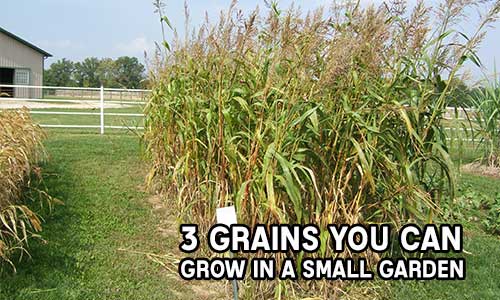3 Grains You Can Grow In A Small Garden
Whole grains are important to any healthy diet. They’re low in fat, high in fiber, and filling to eat. A diet rich in grains is also know to help reduce the risk of heart disease, diabetes, and certain cancers. Unfortunately, fewer than 5 percent of Americans are estimated to get adequate grains. In gluten-free homes like mine, getting enough grains can be even tougher. I’ve recently found a way, however, to grow small patches of gluten-free grains in a home garden. Outlined here are a few of my favorites.
Buckwheat
Buckwheat is not only gluten-free, it makes a wonderful flour for baking and homemade pancakes. Buckwheat grows to about two feet tall and can be intermixed with other plants, a great natural pest barrier!
To grow buckwheat, it’s advised to plant for a fall harvest approximately three months before the first hard frost. You can grow in either an in-ground plot or a raised bed. The tradeoff to plots is that the plants seem stronger and taller, but the germination rate isn’t as good as a raised bed. With the raised bed method, a mix of 1:1 of topsoil to compost is recommended.
Spread the seeds evenly in your planting area, careful not to overdo it, as this can cause crowding in mature plants. Sprinkle compost over the seeds and water regularly until seedlings sprout up. The germination process is relatively quick for buckwheat.
The ideal time to harvest is when approximately 75% of the seeds are dark. Waiting too long will cause many seeds to fall to the ground and be wasted. For baking flower, mill the seeds and sift the husks from the mixture.
Amaranth
Amaranth is a truly versatile grain. While some people grow it simply for the beauty of the flowers, the leaves of amaranth are edible, and those tiny little amaranth seeds are big on protein! In fact, one cup of cooked amaranth has nine grams of protein power within.
The preferred method of planting is to start the seeds in the house, then move them outside after the last frost. Plants should be spaced 12 inches to allow for growth. The plants will grow freely, but need to be staked near the end of their cycle, as the seed heads become too heavy for the plant to support. Keep an eye on amaranth’s ability to spread as it can become invasive. The little red seedlings that pop up far and wide can simply be relocated.
Amaranth should be harvested right before a frost. If the seeds fall freely into your hands when you rub a flower, you know they are ready to harvest. To harvest, first cut the stalks down. To remove the seeds from the flower head, place a window screen over a large container, and with gloved hands, rub the flower heads against the screen. The seeds will fall through the screen into
the container below. Some seeds are bound to be lost in this process, so be sure you’re screening over an area where reseeding won’t be an issue.
To clean the grain of errant bits of flower, you can winnow the amaranth seeds either with a fan on low speed or the more traditional way of lightly tossing the grain in the breeze and letting the chaff float off of the seeds.
Sorghum
There are a lot of similarities in appearance between sorghum and corn. Sorghum can grow to eight feet tall with a large beaded tassel. Sorghum stalks are grown to make syrup in the south, but for our purposes, I will stick to growing and harvesting seeds.
Like corn, sorghum should be planted after the last frost. Seeds should be spaced about 12 inches to allow for growth. If planted in a raised bed, sorghum stalks will likely need to be staked, but in a plot I find they grow strong enough to stand alone.
The time to harvest sorghum is when the seeds change to a dark color, usually near the first frost. To harvest, cut the stalks down and remove the heads. I recommend going to a hardware store and buying a piece of hardware cloth that you can put over a bucket. With gloved hands, simply rub the seed head against the metal and the seeds will fall into the bucket. As with amaranth, winnowing the grains may need to be done after harvest, and like buckwheat, you can mill the grains and sift the husks.
For more articles like this, remember to “LIKE” us on Facebook so you stay up-to-date.






